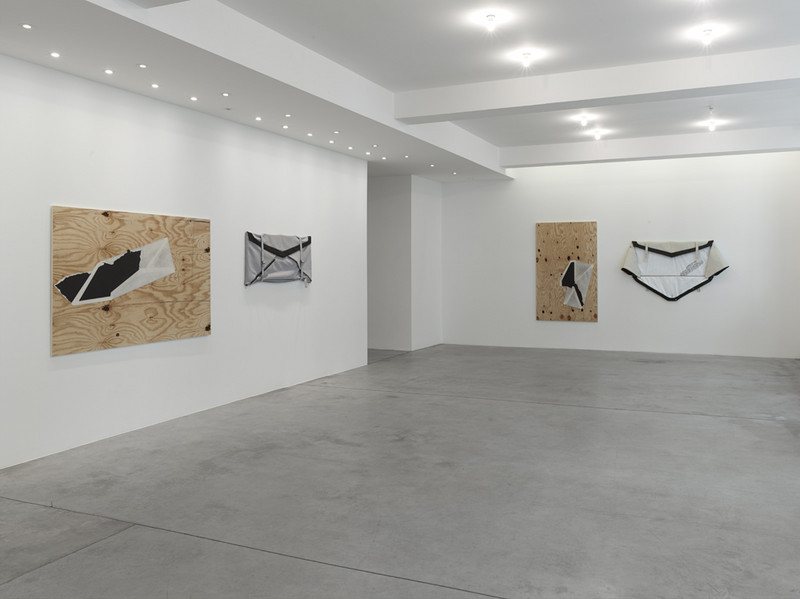Seth Price
07 Jun - 31 Aug 2013
SETH PRICE
7 June - 31 August
For his second exhibition at the gallery, Seth Price presents ten new works that articulate the form of a standard business envelope: once as a series of screen prints on plywood, and again as wall-based sculptures fabricated with materials and techniques borrowed from the fashion/garment trade. One series involves a hands-on, artisanal, completely in-studio process, whereas the other relies on outsourced art labor.
The works on plywood (a “wood product” which is itself composed of layers) are a sort of Photoshop in real life, hand made by gradually building up white grounds in advance of the prints, then adding multiple layers of matte black gesso on top of the printed surfaces. So the work arrives as an accretion of material densities in actual space. Price designed a prototype for these envelopes on the computer, printed it out, then cut, folded and glued its edges to generate paper models. He then tore the models open and rescanned them backonto the computer to make the images we see printed on the plywood. Delivered in slow motion, these works finally arrive with the weight and thickness of sculptural things.
To produce his textile works, Price worked with a professional pattern maker and a factory in Manhattan’s garment district. Each envelope's main shell fabric (the "self," as it's called in the industry) is composed of a slightly "tech" material, including a high performance sports mesh, a waxed canvas, and Neoprene, a synthetic rubber. These materials are faced with blackened cork and trimmed with snaps, zippers, straps and buckles. The artist has hand stamped or screenprinted patterns on the envelopes’ Tyvek linings, which are exposed or hidden from view depending on how each work is styled on the wall. Like designer accessories, these works operate in terms of both structure and style and, hung here like pelts, are finally delivered as display. Here, sculpture is displaced within the channel of fashion: how might one enact sculpture within the logic of garment construction?
With its mechanized mass production in the mid-19th century, the adhesive envelope submitted authorship to a standard format, ensuring the extension of a postal system that enclosed its users within a communicating circuit. Its folds produce an interior space that allows private communication while seeming to preserve the presence of a Romantic author or soul in the moment of transmission. Displaying the material basis of modern communication without including any message or address, Price seems to capture the spirit of communication itself. In advance of the faster, ever more immersive communications networks we use today, the postal system could only take off by standardizing both its materials and its subjects. Here, the empty envelope appears as the anonymous, mask-like face of information that summons its own operators, or the fetish that momentarily completes an individual within the constant revolutions of a closed circuit.
John Kelsey
7 June - 31 August
For his second exhibition at the gallery, Seth Price presents ten new works that articulate the form of a standard business envelope: once as a series of screen prints on plywood, and again as wall-based sculptures fabricated with materials and techniques borrowed from the fashion/garment trade. One series involves a hands-on, artisanal, completely in-studio process, whereas the other relies on outsourced art labor.
The works on plywood (a “wood product” which is itself composed of layers) are a sort of Photoshop in real life, hand made by gradually building up white grounds in advance of the prints, then adding multiple layers of matte black gesso on top of the printed surfaces. So the work arrives as an accretion of material densities in actual space. Price designed a prototype for these envelopes on the computer, printed it out, then cut, folded and glued its edges to generate paper models. He then tore the models open and rescanned them backonto the computer to make the images we see printed on the plywood. Delivered in slow motion, these works finally arrive with the weight and thickness of sculptural things.
To produce his textile works, Price worked with a professional pattern maker and a factory in Manhattan’s garment district. Each envelope's main shell fabric (the "self," as it's called in the industry) is composed of a slightly "tech" material, including a high performance sports mesh, a waxed canvas, and Neoprene, a synthetic rubber. These materials are faced with blackened cork and trimmed with snaps, zippers, straps and buckles. The artist has hand stamped or screenprinted patterns on the envelopes’ Tyvek linings, which are exposed or hidden from view depending on how each work is styled on the wall. Like designer accessories, these works operate in terms of both structure and style and, hung here like pelts, are finally delivered as display. Here, sculpture is displaced within the channel of fashion: how might one enact sculpture within the logic of garment construction?
With its mechanized mass production in the mid-19th century, the adhesive envelope submitted authorship to a standard format, ensuring the extension of a postal system that enclosed its users within a communicating circuit. Its folds produce an interior space that allows private communication while seeming to preserve the presence of a Romantic author or soul in the moment of transmission. Displaying the material basis of modern communication without including any message or address, Price seems to capture the spirit of communication itself. In advance of the faster, ever more immersive communications networks we use today, the postal system could only take off by standardizing both its materials and its subjects. Here, the empty envelope appears as the anonymous, mask-like face of information that summons its own operators, or the fetish that momentarily completes an individual within the constant revolutions of a closed circuit.
John Kelsey

